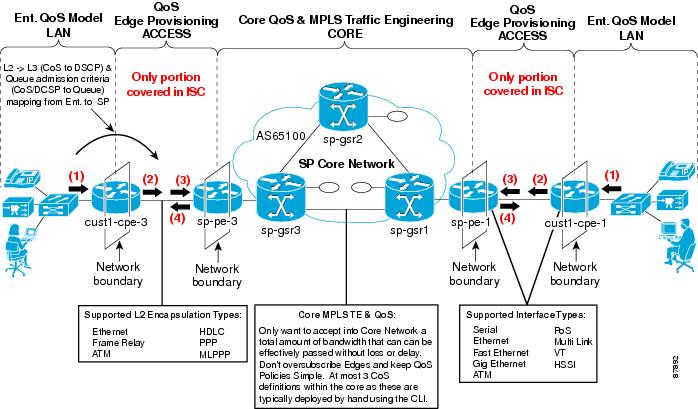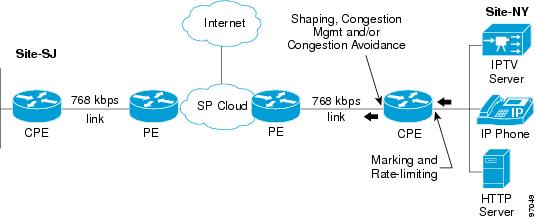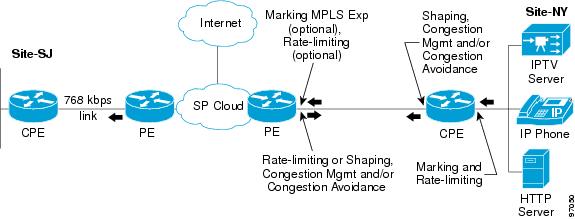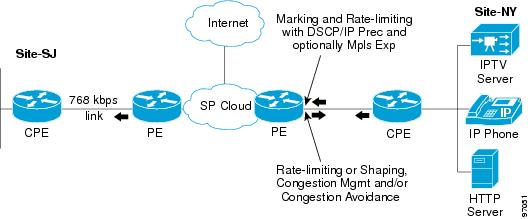

Table Of Contents
Service Provider Network Architecture
IP QoS Provisioning Strategies
Ethernet QoS Provisioning Strategies
Network Architecture
A service provider network architecture contains access routers, distributed routers and core routers or ATM switches. Access routers terminate customer connections at the edge of the network.
IP QoS provisioning with the Cisco IP Solution Center (ISC) is configured on the access circuit that involves the access router (provider edge devices, or PEs) in the service provider network and the customer premise equipment (CPEs) in the customer network.
Ethernet QoS provisioning with ISC supports a subset of the features required for the Metro Ethernet 2.1 Solution (Upper Kensington). With Ethernet QoS, ISC can deploy QoS Policies on Cisco Catalyst switches in a provider's network.
This chapter includes the following sections:
•
Service Provider Network Architecture
•
IP QoS Provisioning Strategies
•
Ethernet QoS Provisioning Strategies
Service Provider Network Architecture
The service provider network architecture, supported within the scope of the IP QoS provisioning model in ISC is:
•
Access circuit (CPEs)
•
Distribution routers (PEs)
•
Core (routers and ATM switches)
These QoS components and concepts are represented in Figure 2-1.
Figure 2-1 QoS Components and Concepts
IP QoS Service Model
The IP QoS service model in ISC is designed so that QoS provisioning is implemented for traffic that enters the access circuit at the network edge (CPE), and through the distribution portion (the CPE-PE link).
This type of IP QoS provisioning involves traffic through several different types of devices, link speeds, and encapsulation types. For this reason, an ISC QoS policy is divided into two categories:
•
Service level IP QoS policy-The service level policy corresponds to IP QoS service classes. QoS service classes provide a method for classifying traffic.
Typically, a service provider creates 3 or 4 service classes for each QoS policy. For example, a service provider might have a Platinum, Gold, Silver, and Bronze QoS policies, and each of these policies might contain 3 service classes; a VoIP, a management, and a data service class (Best-Effort or Business-Data-1).
•
Link level QoS policy—The link level QoS policy is a grouping of QoS parameters that are sensitive to the CPE-PE link's bandwidth and layer 2 encapsulation. Link level parameters include Frame-Relay traffic shaper, ATM shaper, FRF.12, LFI over MLPPP, cRTP, and interface-based rate limiting.
Typically, a service provider creates several link level QoS settings. For example, a service provider might create a link QoS setting for different bandwidths and encapsulation types, such as; FR_64K_gold, FR_64K_silver, FR_128K_bronze, ATM_1MBPS_gold, and Ethernet_2mbps_Silver.
ISC provides two levels of QoS policies because a QoS service request might contain one or more links with different circuit bandwidths and encapsulation types. The service level policy is designed for a type of service, like voice, but can apply to more than one link type. The link level policy is designed for different link speeds, like 1 Mbps, and can apply QoS provisioning per link.
To provision QoS parameters for devices in a service request, a network operator must:
•
Select the appropriate service-level QoS policy
•
Associate a corresponding link level policy with each link in the service request.
For example, if the QoS service request is comprised of two links; a Frame-Relay link with a bandwidth of 64kbps, and an ATM link, with a bandwidth of 1 mbps, and the service level agreement (SLA) purchased by the enterprise customer is the Gold policy, the following settings might be associated with the QoS service request:
–
Gold service-level QoS policy
–
FR_64K_gold link level QoS settings tied to the Frame Relay link
–
ATM_1MBPS_gold link level QoS settings tied to the ATM link
QoS policies can either be customer-oriented or provider-oriented. Typically, service provider networks have a combination of both service level and link level QoS policies.
For more information on the QoS service model, see "QoS Service Model Overview."
IP QoS Provisioning Strategies
ISC configures IP QoS at the access circuit, which involves the PE devices in the service provider network and the CPE devices in the customer network. A QoS policy is applied to the selected set of access circuits using a QoS service request.
Typically, the points of congestion in the access circuit are:
•
The provider-facing interface on the CPE, with traffic flowing from the CPE to the PE (egress traffic).
•
The customer-facing interfaces on the PE, with traffic flowing from the PE to the CPE (egress traffic).
This section describes a QoS provisioning strategy: where the congestion points in the network might be, where to apply QoS parameters, and which QoS provisioning components to use.
Managed CPE Scenario
A managed CPE scenario occurs when the CPE is owned and managed by the service provider. In this network scenario, you can either apply QoS provisioning for the CPE only or for both the CPE and PE.
This section describes QoS provisioning strategies for both CPE only and CPE-PE scenarios.
Managed CPE Only
Figure 2-2 illustrates a network where QoS provisioning is configured only for the managed CPE device.
Figure 2-2 Managed CPE Scenario
In this QoS provisioning scenario:
•
Optionally configure marking and rate limiting at the customer-facing CPE interface so that packets can be marked before they are encapsulated by the IPSec, GRE, and L2F and L2TP tunnels. - IPsec and GRE are not supported in this release. -
•
Configure traffic shaping, congestion management, and congestion avoidance at the provider-facing CPE interface and subinterfaces.
Managed CPE and PE
Figure 2-3 illustrates a network where QoS provisioning is configured for both the managed CPE and the PE device.
Figure 2-3 Managed CPE and PE Scenario
In this QoS provisioning scenario:
•
For traffic flowing from the CPE to the PE, marking and rate-limiting are configured at the customer-facing CPE interfaces, while traffic shaping, congestion management, and congestion avoidance are configured at the provider-facing CPE interfaces and subinterfaces.
•
For traffic flowing from the PE to the CPE, QoS configuration is applied at customer-facing interfaces and subinterface for the PE. The configuration at the PE interfaces might be symmetrical to what is configured at provider-facing interfaces of a CPE, but it is not required.
•
If you are provisioning QoS for an MPLS VPN and you enable MPLS marking in the service level QoS policy, marking with MPLS experimental values is configured at the customer-facing PE interfaces and subinterfaces for traffic flowing from CPE to PE.
Unmanaged CPE Scenario
An unmanaged CPE scenario occurs when the CPE is not owned by the service provider, but ISC is aware of the device configuration and interface information. This information must be provided by the owner of the CPE device.
In this QoS provisioning scenario:
•
You must first create the CPE device in ISC so that the device configuration and interface information can be stored in the ISC repository. A configlet is generated for the unmanaged CPE, however, the configlet is not downloaded to the unmanaged CPE device. A configuration audit is not performed for the unmanaged CPE device.
See Cisco IP Solution Center Infrastructure Reference, 4.0 for more information on manually creating CPE devices.
•
An untrusted CPE is either not managed by the service provider or is only partially-managed by the service provider. We recommend that you re-mark and re-rate limit at the provider ingress interface for the untrusted CPE device. Configure the re-marking and re-rate limiting parameters in the service level policy.
See Creating the Service Level IP QoS Policy for more information.
PE Only Scenario
For a PE only scenario, the service provider's enterprise customer is responsible for applying the QoS configuration at the CPE interfaces.
Figure 2-4 PE Only Scenario
In this QoS provisioning scenario:
•
For traffic flowing from the CPE device to the PE device, configure marking and rate-limiting at customer-facing interfaces of the PE device.
•
For traffic flowing from the PE device to the CPE device, configure traffic shaping, rate-limiting, congestion management, and congestion avoidance at the same customer-facing interfaces and subinterfaces of the PE device.
See "Provisioning Process for IP QoS," for more information on the QoS provisioning process.
Ethernet QoS Service Model
The Ethernet QoS service model in ISC is designed so that QoS provisioning is implemented for traffic that enters the access circuit at the network edge (CPE), and through the distribution portion (the CPE-PE link).
Ethernet QoS policies correspond to Ethernet QoS service classes. QoS service classes provide a method for classifying traffic.
A typical service provider network might create different QoS policies, and each QoS policy might contain 3 to 4 service classes. For example, a service provider might have gold, silver, and bronze QoS policies, each specifying different service level agreements (SLA), and each of those QoS policies might contain one or more service classes. Most networks require at least a voice and a data service class.
To provision Ethernet QoS parameters for devices in a service request, a network operator must:
•
Create an Ethernet QoS Policy as described in Service Level Ethernet QoS Policy.
•
Create a QoS service request.
•
Select a customer.
•
Select a service request for L2VPN, VPLS, or MPLS (the service request must already exist).
•
Select a QoS Policy created for Ethernet QoS.
•
Save the service request.
•
Deploy the service request.
Ethernet QoS policies can either be customer-owned or provider-owned.
For more information on the Ethernet QoS service model, see "Applying QoS Policies to VPN Services".
Ethernet QoS Provisioning Strategies
Each Ethernet link in a service request (L2VPN, MPLS, or VPLS) might contain one or two attachment circuits (end-to-end link). Each attachment circuit corresponds to one point-to-cloud QoS Link. A link contains one or two end-points: PE-CLE and PE-POP
An Ethernet QoS service request binds one or more QoS links to a QoS policy. A QoS template can be attached to each end-point in a QoS link.
In a service-provider managed Ethernet QoS environment, the following three points in the access circuit are regarded as potential points of congestion:
•
PE-CLE provider facing interface(s) with traffic flowing from PE-CLE to PE-POP (egress traffic)
•
PE-POP customer facing interface(s) with traffic flowing from PE-POP to PE-CLE (egress traffic)
•
PE-CLE customer UNI interfaces) with traffic flowing from PE-CLE to customer LAN
Figure 2-5 shows the Ethernet QoS points of congestion.
Figure 2-5 Ethernet QoS Points of Congestion

 Feedback
Feedback



